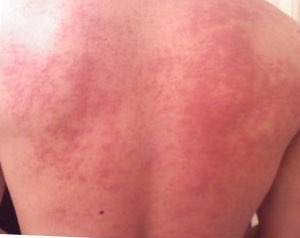Soy allergy

Editor-In-Chief: Prab R Tumpati, MD
Obesity, Sleep & Internal medicine
Founder, WikiMD Wellnesspedia &
W8MD medical weight loss NYC and sleep center NYC
| Soy allergy | |
|---|---|

| |
| Synonyms | N/A |
| Pronounce | N/A |
| Specialty | N/A |
| Symptoms | Hives, itching, swelling, abdominal pain, diarrhea, nausea, anaphylaxis |
| Complications | N/A |
| Onset | Minutes to hours after exposure |
| Duration | Variable, can be chronic with repeated exposure |
| Types | N/A |
| Causes | Immune system reaction to soy protein |
| Risks | Family history of allergies, atopic dermatitis |
| Diagnosis | Skin prick test, blood test for IgE antibodies |
| Differential diagnosis | Lactose intolerance, celiac disease, other food allergies |
| Prevention | Avoidance of soy-containing products |
| Treatment | Antihistamines, epinephrine for severe reactions |
| Medication | N/A |
| Prognosis | N/A |
| Frequency | Estimated 0.4% of children, less common in adults |
| Deaths | N/A |





Soy Allergy is a type of food allergy that is triggered by the consumption of soy products. It is one of the more common food allergies, especially among babies and children.
Symptoms[edit]
The symptoms of a soy allergy can range from mild to severe and can include:
- Hives or skin rash
- Itching in the mouth
- Difficulty breathing
- Abdominal pain
- Diarrhea
- Nausea or vomiting
- Dizziness
- Anaphylaxis
Causes[edit]
A soy allergy occurs when the body's immune system mistakenly identifies soy as harmful and creates antibodies against it. When soy is consumed, the immune system releases chemicals such as histamine, which cause allergy symptoms.
Diagnosis[edit]
A soy allergy is typically diagnosed through a combination of a patient history, skin prick test, and blood test. In some cases, an oral food challenge may be conducted under medical supervision.
Treatment[edit]
The primary treatment for a soy allergy is avoidance of soy products. This can be challenging, as soy is found in many processed foods. In cases of accidental ingestion, antihistamines may be used to relieve symptoms. In severe cases, such as anaphylaxis, emergency treatment with epinephrine is required.
Additional images[edit]
-
Tempeh
-
Textured vegetable protein
-
US Allergen Information Example
See Also[edit]
Ad. Transform your life with W8MD's Budget GLP-1 injections from $75


W8MD offers a medical weight loss program to lose weight in Philadelphia. Our physician-supervised medical weight loss provides:
- Weight loss injections in NYC (generic and brand names):
- Zepbound / Mounjaro, Wegovy / Ozempic, Saxenda
- Most insurances accepted or discounted self-pay rates. We will obtain insurance prior authorizations if needed.
- Generic GLP1 weight loss injections from $75 for the starting dose.
- Also offer prescription weight loss medications including Phentermine, Qsymia, Diethylpropion, Contrave etc.
NYC weight loss doctor appointmentsNYC weight loss doctor appointments
Start your NYC weight loss journey today at our NYC medical weight loss and Philadelphia medical weight loss clinics.
- Call 718-946-5500 to lose weight in NYC or for medical weight loss in Philadelphia 215-676-2334.
- Tags:NYC medical weight loss, Philadelphia lose weight Zepbound NYC, Budget GLP1 weight loss injections, Wegovy Philadelphia, Wegovy NYC, Philadelphia medical weight loss, Brookly weight loss and Wegovy NYC
|
WikiMD's Wellness Encyclopedia |
| Let Food Be Thy Medicine Medicine Thy Food - Hippocrates |
Medical Disclaimer: WikiMD is not a substitute for professional medical advice. The information on WikiMD is provided as an information resource only, may be incorrect, outdated or misleading, and is not to be used or relied on for any diagnostic or treatment purposes. Please consult your health care provider before making any healthcare decisions or for guidance about a specific medical condition. WikiMD expressly disclaims responsibility, and shall have no liability, for any damages, loss, injury, or liability whatsoever suffered as a result of your reliance on the information contained in this site. By visiting this site you agree to the foregoing terms and conditions, which may from time to time be changed or supplemented by WikiMD. If you do not agree to the foregoing terms and conditions, you should not enter or use this site. See full disclaimer.
Credits:Most images are courtesy of Wikimedia commons, and templates, categories Wikipedia, licensed under CC BY SA or similar.
Translate this page: - East Asian
中文,
日本,
한국어,
South Asian
हिन्दी,
தமிழ்,
తెలుగు,
Urdu,
ಕನ್ನಡ,
Southeast Asian
Indonesian,
Vietnamese,
Thai,
မြန်မာဘာသာ,
বাংলা
European
español,
Deutsch,
français,
Greek,
português do Brasil,
polski,
română,
русский,
Nederlands,
norsk,
svenska,
suomi,
Italian
Middle Eastern & African
عربى,
Turkish,
Persian,
Hebrew,
Afrikaans,
isiZulu,
Kiswahili,
Other
Bulgarian,
Hungarian,
Czech,
Swedish,
മലയാളം,
मराठी,
ਪੰਜਾਬੀ,
ગુજરાતી,
Portuguese,
Ukrainian




